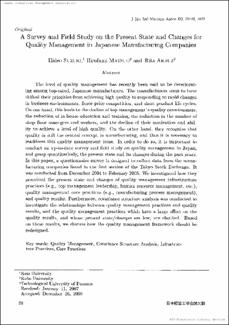Mostrar el registro sencillo del ítem
A survey and field study on the present state and changes for quality management in Japanesse manufacturing companies
| dc.contributor.author | Suzuky, Hideo | |
| dc.contributor.author | Matsuo, Hirofumi | |
| dc.contributor.author | Arauz, Rita | |
| dc.date.accessioned | 2017-08-23T16:40:59Z | |
| dc.date.accessioned | 2017-08-23T16:40:59Z | |
| dc.date.available | 2017-08-23T16:40:59Z | |
| dc.date.available | 2017-08-23T16:40:59Z | |
| dc.date.issued | 2009-04-15 | |
| dc.date.issued | 2009-04-15 | |
| dc.identifier.uri | http://ridda2.utp.ac.pa/handle/123456789/2859 | |
| dc.identifier.uri | http://ridda2.utp.ac.pa/handle/123456789/2859 | |
| dc.description | The level of quality management has recently been said to be deteriorating among top-rated, Japanese manufacturers. The manufacturers seem to have shifted their priorities from achieving high quality to responding to rapid changes in business environments, fierce price competition, and short product life cycles. On one hand, this leads to the decline of top management's quality consciousness, the reduction of in-house education and training, the reduction in the number of shop floor managers and workers, and the decline of their motivation and ability to achieve a level of high quality. On the other hand, they recognize that quality is still the central concept in manufacturing, and thus it is necessary to readdress this quality management issue. In order to do so, it is important to conduct an up-to-date survey and field study on quality management in Japan, and grasp quantitatively, the present state and its changes during the past years. In this paper, a questionnaire survey is designed to collect data from the manufacturing companies listed in the first section of the Tokyo Stock Exchange. It was conducted from December 2004 to February 2005. We investigated how they perceived the present state and changes of quality management infrastructure practices (e.g., top management leadership, human resource management, etc.), quality management core practices (e.g., manufacturing process management), and quality results. Furthermore, covariance structure analysis was conducted to investigate the relationships between quality management practices and quality results, and the quality management practices which have a large effect on the quality results, and whose present state/changes are low, are clarified. Based on these results, we discuss how the quality management framework should be redesigned. | en_US |
| dc.description.abstract | The level of quality management has recently been said to be deteriorating among top-rated, Japanese manufacturers. The manufacturers seem to have shifted their priorities from achieving high quality to responding to rapid changes in business environments, fierce price competition, and short product life cycles. On one hand, this leads to the decline of top management's quality consciousness, the reduction of in-house education and training, the reduction in the number of shop floor managers and workers, and the decline of their motivation and ability to achieve a level of high quality. On the other hand, they recognize that quality is still the central concept in manufacturing, and thus it is necessary to readdress this quality management issue. In order to do so, it is important to conduct an up-to-date survey and field study on quality management in Japan, and grasp quantitatively, the present state and its changes during the past years. In this paper, a questionnaire survey is designed to collect data from the manufacturing companies listed in the first section of the Tokyo Stock Exchange. It was conducted from December 2004 to February 2005. We investigated how they perceived the present state and changes of quality management infrastructure practices (e.g., top management leadership, human resource management, etc.), quality management core practices (e.g., manufacturing process management), and quality results. Furthermore, covariance structure analysis was conducted to investigate the relationships between quality management practices and quality results, and the quality management practices which have a large effect on the quality results, and whose present state/changes are low, are clarified. Based on these results, we discuss how the quality management framework should be redesigned. | en_US |
| dc.language | eng | |
| dc.language.iso | eng | en_US |
| dc.rights | https://creativecommons.org/licenses/by-nc-sa/4.0/ | |
| dc.rights | info:eu-repo/semantics/openAccess | |
| dc.subject | quality management | en_US |
| dc.subject | covariance structure analysis | en_US |
| dc.subject | infrastructure practices | en_US |
| dc.subject | core practices | en_US |
| dc.subject | quality management | |
| dc.subject | covariance structure analysis | |
| dc.subject | infrastructure practices | |
| dc.subject | core practices | |
| dc.title | A survey and field study on the present state and changes for quality management in Japanesse manufacturing companies | en_US |
| dc.type | info:eu-repo/semantics/article | |
| dc.type | info:eu-repo/semantics/publishedVersion |
